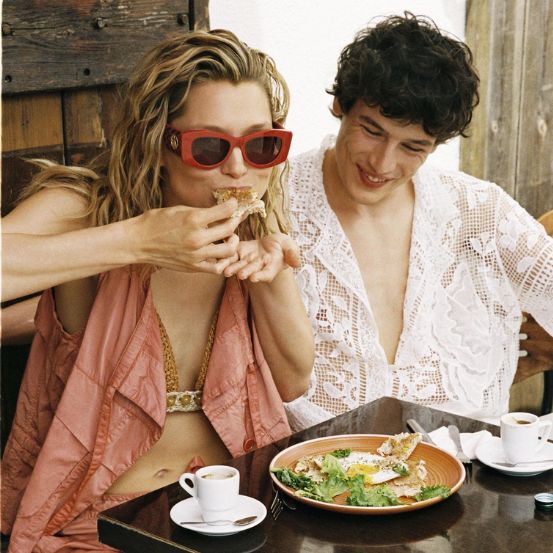The Happiness Issue
Happiness has long been held as life’s ultimate pursuit—etched into manifestos, whispered in affirmations, sold in sleek packaging. We are told to chase it, cultivate it, optimize it. But in an age of relentless self-improvement and curated perfection, has happiness become less of a state and more of a status symbol?
Before questioning whether we’re seeking happiness the right way, we have to ask—what does it even mean to be happy? Is it a fleeting moment of pleasure, or a deeper, more sustained sense of contentment? Philosophers have debated this for centuries, from the ancient Greeks who saw happiness as either a passing pleasure or a life lived with purpose, to modern psychology, which suggests it is neither fixed nor absolute but rather an ever-shifting emotional state. And yet, the modern world has reframed happiness as something to be pursued—an achievement rather than an emotion, an endpoint rather than a process. The paradox? The more we chase it, the more elusive it becomes. Studies show that those who set happiness as a goal often find themselves further from it, trapped in the pressure of their own expectations. Could it be that in our relentless pursuit of happiness, we have overlooked the very things that make it possible?
Happiness is not a singular experience, nor is it universally defined. It is shaped by culture, upbringing, values—by what we are taught to desire and what we are told will fulfill us. The kind of happiness sought in a quiet Nordic winter is not the same as the one found in the vibrant chaos of a Latin American street festival, nor does the happiness of a child resemble that of someone who has lived long enough to know what loss feels like. What brings us joy at one point in our lives may feel hollow at another. And yet, we continue to chase it as though it were one fixed thing—one singular formula that, if only we could unlock it, would provide permanent bliss. But happiness is not static. It shifts, it bends, it molds itself to the seasons of our lives. Perhaps the real question is not whether we are happy, but whether we are allowing our definition of happiness to evolve alongside us.
If happiness is an inner state, why are we constantly encouraged to buy it? The wellness industry, now worth billions, has turned happiness into a commodity—one that can be bottled, branded, and sold in aesthetically pleasing packaging. From mood-boosting skincare to adaptogenic elixirs promising calm in a capsule, we are presented with endless solutions to fix an intangible feeling. The rise of the dopamine economy has only deepened this cycle. Every purchase, every self-improvement course, every “good vibes only” affirmation feeds into the idea that happiness is always just one more step away—one more product, one more habit, one more change. But like all quick fixes, these external solutions often provide only temporary relief, fading as soon as the novelty wears off. And so the search begins again, an endless loop of seeking rather than being.
Even fragrance—the most intangible, emotional of beauty rituals—has now been infused with the promise of mood enhancement. Scents designed not to evoke memory or tell a story, but to fix something, to make us feel brighter, lighter, more balanced. And perhaps they do, for a moment. But if happiness could be spritzed onto the skin, if contentment could be dabbed onto the pulse points, wouldn’t we all be at peace by now? Or is this just another way we’ve learned to mask our emotions, covering up discomfort with something that smells like optimism?
At the same time, we are told to work for our happiness—to hustle, to build, to achieve—while somehow maintaining inner peace along the way. It is the great contradiction of modern ambition: that we should strive for more while also being content with what we have. Hustle culture has convinced us that fulfillment comes through hard work, that success equals happiness. But if that were true, wouldn’t the most ambitious among us also be the most content? Instead, many find themselves exhausted by the pressure to constantly achieve yet unable to slow down without feeling unproductive. Rest is seen as indulgent, slowing down as failure. Even happiness itself has become something we must work for—another goal to optimize, another milestone to reach.
There’s a phrase that lingers in modern conversations: We are never content because we are always raising the bar. We convince ourselves that happiness will come with the next promotion, the next milestone, the next version of ourselves. But as soon as we reach it, the bar moves again. We are chasing something that moves alongside our own movement, something that was never designed to be caught. And so the finish line keeps stretching further and further away, until happiness becomes not something we experience, but something we are perpetually aiming for.
The expectation to be happy at all times is not just unrealistic—it’s harmful. Social media has transformed happiness into something performative, a mood to be captured, curated, and displayed rather than genuinely felt. The pressure to project joy, even when it’s absent, has created a culture where struggling feels like failure and sadness is something to be hidden rather than understood. We are bombarded with images of people who seem effortlessly content, their lives curated into neat squares of laughter, soft morning light, and aspirational ease. But these images are carefully constructed, designed to make us compare, to make us wonder if we are the only ones who don’t have it all figured out.
Psychologists warn of the “tyranny of positivity”—the idea that in constantly chasing happiness, we suppress the full range of human emotion. But emotions are cyclical, not linear. The human experience was never meant to be a constant high; even neuroscientists agree that our brains are wired for fluctuation, not permanent euphoria. So why do we keep holding ourselves to an impossible standard? Why do we treat sadness like a problem to be solved rather than a necessary part of being alive?
Perhaps the problem isn’t just how we pursue happiness, but that we’re pursuing the wrong thing entirely. There’s a growing argument that instead of seeking happiness, we should be seeking joy—a subtler, more sustainable emotion that isn’t tied to external validation or achievement. Happiness often feels like an outcome, a reward for a life well-lived. Joy, on the other hand, exists in the in-between moments: the quiet cup of coffee before the world wakes up, the warmth of sunlight filtering through the trees, the feeling of being fully present, even if just for a second. Joy doesn’t demand that we be constantly happy—it allows space for the full spectrum of experience, from melancholy to delight.
Like light, joy cannot exist without its opposite. It is made richer by contrast, given depth by the shadows. Perhaps that is why the most profound joy often comes after moments of sorrow—why laughter feels more real when it arrives after tears, why the first warmth of spring feels sweeter after a long winter. We cannot hold on to joy any more than we can trap light in our hands, but we can stand in its glow when it appears.
Maybe happiness was never meant to be something we chase, but something we notice—something that emerges naturally when we stop trying to force it. It is not a prize to be won, not a metric to be measured, not a destination waiting at the end of a long, arduous journey. It is quieter than that, subtler than that. It arrives unexpectedly, in the space between moments, in the gaps we are so often too busy to see.
Think back to the last time you felt it—not the kind of happiness that could be posted, or shared, or neatly categorized, but the kind that simply was. Perhaps it was in the first sip of coffee on a slow morning, in the way the light caught the dust in the air, swirling like golden flecks of something almost magical. Perhaps it was in a laugh that escaped your lips before you had the chance to stifle it, or in the deep exhale of a long-held breath, realizing for a moment that everything was, somehow, okay. Maybe it was in the silence of a night where you felt, just for a second, like you belonged to the world exactly as you were.
If we strip away the expectations, the pressure, the curated projections of what happiness should look like—what remains? If we let go of the need to constantly document, to prove, to validate our joy, does it become easier to hold? Maybe happiness was never meant to be something we achieve but something we allow ourselves to receive—a state of being that flows in and out, like the tide, like breath, like light shifting through the hours of the day.
And maybe that is why we have been searching for it in all the wrong places. We have been conditioned to believe that happiness is found in the grand, the monumental, the extraordinary. But perhaps it is most abundant in the ordinary—the everyday glimmers, the unnoticed seconds that slip through our fingers when we are too focused on the pursuit to recognize that, for a fleeting instant, we had already arrived.
What if instead of seeking happiness, we allowed ourselves to experience the full depth of human emotion? To sit with longing without rushing to escape it, to embrace stillness without feeling unproductive, to feel joy without needing to capture or contain it? What if we understood that sadness is not failure, that contentment is not complacency, that being present in a moment—truly present—is a greater act of fulfillment than any self-improvement regimen could ever offer?
The pursuit of happiness may always be a part of us. We are creatures of longing, after all, drawn to light, to warmth, to love in all its forms. But perhaps the real secret is this: a life well-lived is not one that is always happy, but one that is deeply felt. A life where we do not measure our worth by how often we laugh, but by how openly we allow ourselves to experience the spectrum of what it means to be human. Where we do not rush past grief, or numb discomfort, or dismiss the beauty of a quiet, unremarkable day.
And perhaps, in the end, that is enough. To be here, fully. To be alive, wholly. To feel it all.
Translated from the original in The Happiness Issue, published march 2025. For full stories and credits, check the print issue.
Relacionados

.png)
Da MAC para o Mundo: tudo o que importa saber sobre as tendências de maquilhagem atuais
09 Apr 2025
.jpg)
.jpg)





.jpg)